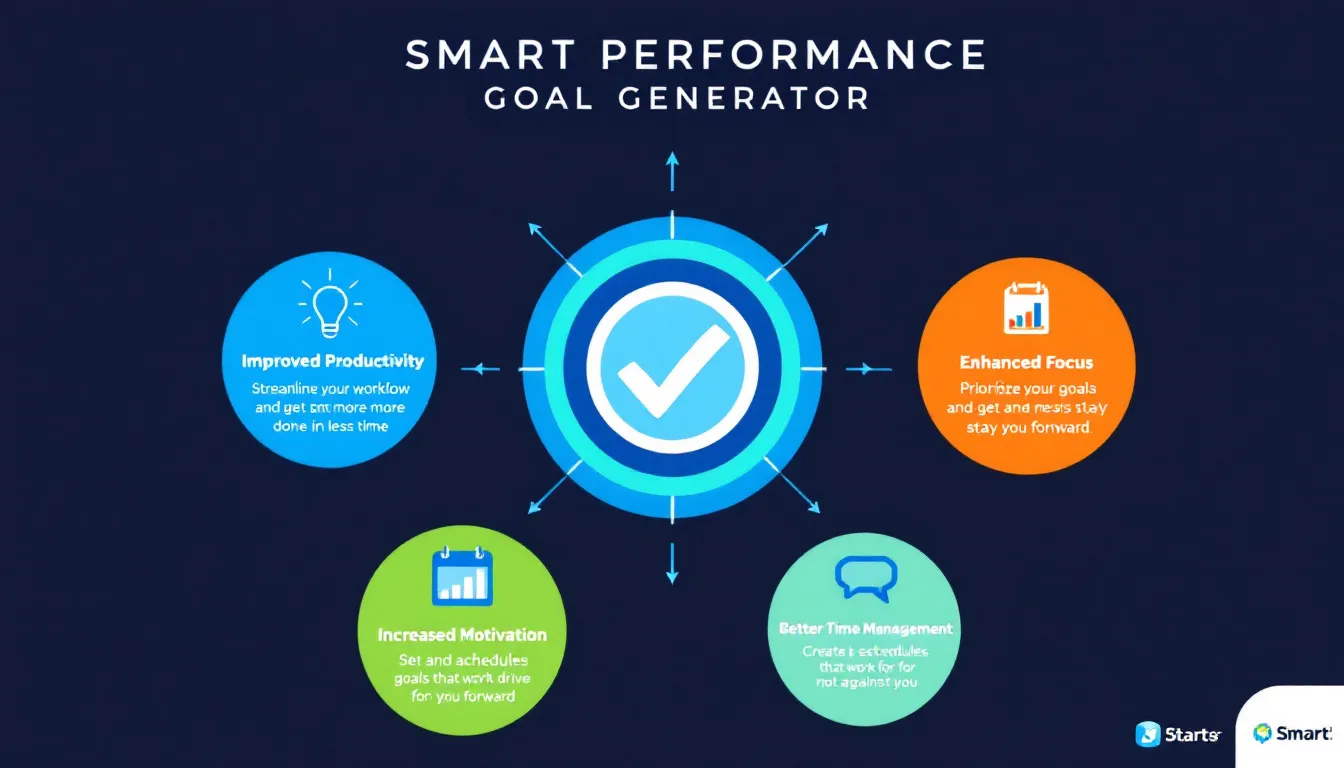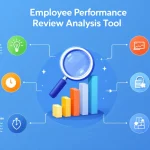Is this tool helpful?
How to Use the Performance Goal Setting Tool Effectively
To make the most of our Performance Goal Setting Tool, follow these steps:
- Enter the Job Position: In the first field, input the specific job position for which you’re setting a performance goal. For example, you might enter “Marketing Manager” or “Frontend Developer”.
- Outline Organizational Objectives: In the second field, describe the key organizational objectives relevant to the position. For instance, you could enter “Increase brand awareness by 30% in the next fiscal year” or “Reduce customer churn rate by 15% within six months”.
- List Key Responsibilities: Detail the main responsibilities of the position in the third field. Examples could include “Manage a team of 8 marketing specialists” or “Develop and implement SEO strategies for the company’s e-commerce platform”.
- Provide Recent Performance Data (Optional): If available, enter recent performance trends or data for the position. This could be something like “Achieved 110% of lead generation targets in Q2” or “Reduced website load time by 40% in the last sprint”.
- Mention Upcoming Challenges or Opportunities (Optional): In the last field, note any known future factors that could impact performance. For example, “Upcoming merger with a competitor in Q4” or “Launch of a new product line in the Asian market”.
- Generate the Performance Goal: Click the “Generate Performance Goal” button to receive a tailored, SMART (Specific, Measurable, Achievable, Relevant, Time-bound) performance goal based on your inputs.
- Review and Copy: Once generated, review the performance goal in the results section. If satisfied, use the “Copy to Clipboard” button to easily transfer the goal to your performance management system or document.
By providing detailed and thoughtful information in each field, you’ll receive a more accurate and relevant performance goal that aligns with both the individual’s role and the organization’s objectives.
Unlocking Potential: The Power of Effective Performance Goal Setting
In today’s dynamic business environment, setting clear, actionable, and motivating performance goals is crucial for driving individual and organizational success. Our Performance Goal Setting Tool is designed to streamline this process, ensuring that goals are not just set, but are strategically crafted to align with both the employee’s role and the company’s overarching objectives.
This innovative tool leverages the principles of SMART goal setting – Specific, Measurable, Achievable, Relevant, and Time-bound – to create performance goals that are both challenging and attainable. By considering factors such as job responsibilities, organizational objectives, recent performance trends, and upcoming challenges or opportunities, our tool generates tailored goals that foster professional growth and enhance productivity.
The Science Behind Effective Goal Setting
Research in organizational psychology has consistently shown that well-defined goals can significantly impact performance. A study by Locke and Latham (2002) found that specific and challenging goals led to higher performance 90% of the time compared to easy goals or vague encouragements to “do your best”. Our Performance Goal Setting Tool builds on this research, ensuring that each generated goal is:
- Specific: Clearly defining what needs to be accomplished
- Measurable: Including quantifiable metrics for success
- Achievable: Challenging yet realistic given the employee’s capabilities
- Relevant: Aligned with broader organizational objectives
- Time-bound: Setting a clear deadline for achievement
By incorporating these elements, the tool creates goals that are not only more likely to be achieved but also contribute meaningfully to both individual and organizational success.
Benefits of Using the Performance Goal Setting Tool
1. Alignment with Organizational Objectives
One of the primary benefits of our tool is its ability to create goals that directly align with the organization’s strategic objectives. This alignment ensures that every employee’s efforts contribute to the company’s overall success. For instance, if a company’s objective is to increase market share, the tool might generate a goal for a sales representative to “Acquire 15 new enterprise clients in the next quarter, focusing on the healthcare sector to support the company’s market expansion strategy.”
2. Increased Employee Engagement and Motivation
When employees have clear, achievable goals that are directly tied to their roles and the company’s success, they’re more likely to feel engaged and motivated. A study by Gallup found that employees whose managers involve them in goal setting are 3.6 times more likely to be engaged than those who aren’t involved. Our tool facilitates this engagement by creating goals that are tailored to the individual’s position and capabilities.
3. Enhanced Performance Measurement
The SMART goals generated by our tool provide clear metrics for measuring performance. This clarity not only helps employees understand what’s expected of them but also enables managers to provide more objective and constructive feedback. For example, a goal like “Improve customer satisfaction ratings from 7.5 to 8.5 out of 10 within the next six months by implementing a new customer feedback system and addressing the top three customer pain points” provides a clear benchmark for success.
4. Facilitates Professional Development
By considering an employee’s current performance and future challenges, the tool can create goals that push for growth and development. This might include goals related to acquiring new skills, taking on additional responsibilities, or improving in specific areas. For instance, “Complete an advanced project management certification and successfully lead two cross-departmental projects by the end of the fiscal year” encourages professional growth while contributing to organizational needs.
5. Saves Time and Ensures Consistency
Setting effective performance goals can be time-consuming, especially for managers overseeing large teams. Our tool streamlines this process, generating well-crafted goals in minutes. This not only saves time but also ensures consistency in goal quality across different departments and levels of the organization.
6. Adaptability to Changing Circumstances
By incorporating fields for recent performance data and upcoming challenges or opportunities, the tool allows for the creation of goals that are responsive to changing business environments. This adaptability is crucial in today’s fast-paced business world, where goals may need to be adjusted to reflect new realities.
Addressing User Needs: How the Performance Goal Setting Tool Solves Specific Problems
Problem 1: Lack of Alignment Between Individual and Organizational Goals
Many organizations struggle with ensuring that individual employee goals contribute directly to the company’s overall objectives. Our tool addresses this by requiring input on organizational objectives and using this information to craft goals that inherently support these broader aims.
Example: For a Content Marketing Specialist in a company aiming to increase organic traffic by 50% in the next year, the tool might generate the following goal:
“Develop and implement a comprehensive content strategy that increases organic website traffic by 25% in the next six months. This should include creating 24 high-quality, SEO-optimized blog posts targeting key industry keywords, and establishing guest posting relationships with 10 authoritative industry websites to build quality backlinks.”
This goal directly contributes to the company’s objective while providing clear, measurable targets for the employee.
Problem 2: Goals That Are Too Vague or Unmeasurable
Vague goals like “improve customer service” or “increase productivity” are common but ineffective. They lack specificity and measurability, making it difficult for employees to know what’s expected and for managers to evaluate performance accurately.
Example: For a Customer Service Team Leader, instead of a vague goal to “improve customer service,” our tool might generate:
“Increase the team’s average customer satisfaction score from 8.2 to 9.0 out of 10 within the next quarter by implementing a new customer feedback system, providing weekly team training sessions on effective communication techniques, and reducing average response time to customer inquiries from 4 hours to 2 hours.”
This goal is specific, measurable, and provides clear actions for achievement.
Problem 3: Goals That Don’t Consider Recent Performance or Future Challenges
Static goals that don’t take into account an employee’s recent performance or upcoming challenges can be demotivating or unrealistic. Our tool addresses this by incorporating fields for recent performance data and upcoming challenges or opportunities.
Example: For a Sales Manager who has consistently exceeded targets but is facing a new competitor entering the market, the tool might generate:
“Building on your success in exceeding sales targets by an average of 15% over the past two quarters, achieve a 20% increase in sales revenue in the upcoming quarter while maintaining a customer retention rate of 90% or higher. Develop and implement a competitive strategy to address the new market entrant, including creating a detailed comparison guide for the sales team and conducting bi-weekly market analysis sessions.”
This goal acknowledges past performance, sets a higher target, and addresses the upcoming challenge of new competition.
Practical Applications: Real-World Examples of the Performance Goal Setting Tool in Action
Example 1: Software Development Team Lead
Inputs:
- Position: Software Development Team Lead
- Organizational Objectives: Launch new mobile app, improve software quality
- Key Responsibilities: Manage team of 6 developers, oversee project timelines, ensure code quality
- Recent Performance: Completed last project 2 weeks ahead of schedule
- Upcoming Challenges: Integration of AI features into existing products
Generated Goal: “Lead the development and launch of the new mobile app by Q3, ensuring it meets or exceeds the company’s quality standards with a bug rate of less than 1 per 1000 lines of code. Simultaneously, spearhead the integration of AI features into two existing products by conducting bi-weekly AI integration workshops with the team and collaborating with the AI department to develop a comprehensive integration roadmap by the end of Q2. Maintain the team’s high performance by keeping project delivery times 10% ahead of schedule and improving team velocity by 15% through the implementation of advanced Agile methodologies.”
Example 2: Human Resources Manager
Inputs:
- Position: Human Resources Manager
- Organizational Objectives: Improve employee retention, enhance company culture
- Key Responsibilities: Oversee recruitment, manage employee relations, develop training programs
- Recent Performance: Reduced time-to-hire by 20%
- Upcoming Challenges: Company expanding to new geographic location
Generated Goal: “Develop and implement a comprehensive employee retention strategy that reduces voluntary turnover rate from 15% to 10% within the next 12 months. This should include launching a structured mentorship program, conducting monthly ‘stay interviews’ with high-performing employees, and creating a data-driven approach to identify and address key factors influencing employee satisfaction. Additionally, lead the HR initiatives for the company’s geographic expansion by designing a culturally adaptive onboarding program for the new location and successfully recruiting 90% of the required positions for the new office within 6 months, while maintaining the recently achieved 20% reduction in time-to-hire.”
Example 3: Marketing Director
Inputs:
- Position: Marketing Director
- Organizational Objectives: Increase market share, improve brand recognition
- Key Responsibilities: Develop marketing strategies, manage budget, lead team of specialists
- Recent Performance: Increased social media engagement by 40%
- Upcoming Challenges: Launch of new product line
Generated Goal: “Spearhead the marketing campaign for the new product line launch, aiming to capture 5% market share within the first six months post-launch. Leverage the recent 40% increase in social media engagement to build pre-launch buzz, targeting a 25% increase in brand mentions across all social platforms one month before the launch date. Develop and implement an integrated marketing strategy that increases overall market share by 3% and improves brand recognition scores from 72 to 80 (out of 100) in industry surveys by the end of the fiscal year. Achieve these objectives while maintaining marketing ROI above 5:1 and nurturing team performance through bi-weekly skill development workshops in emerging marketing technologies.”
Frequently Asked Questions (FAQ)
Q1: How often should performance goals be set or reviewed?
A1: While the frequency can vary depending on the organization and industry, it’s generally recommended to set and review performance goals quarterly or semi-annually. This allows for regular check-ins and adjustments based on changing business needs or circumstances. Our Performance Goal Setting Tool can be used as frequently as needed to ensure goals remain relevant and aligned with organizational objectives.
Q2: Can this tool be used for all levels of employees within an organization?
A2: Yes, our Performance Goal Setting Tool is designed to be versatile and can be used for employees at all levels, from entry-level positions to senior management. The tool’s ability to consider organizational objectives ensures that goals at every level contribute to the company’s overall success.
Q3: How does the tool ensure that goals are challenging yet achievable?
A3: The tool takes into account recent performance data and upcoming challenges or opportunities when generating goals. This helps create goals that push employees to grow and improve while remaining realistic given their current capabilities and circumstances.
Q4: Can I edit or customize the goals generated by the tool?
A4: Absolutely! The goals generated by our tool should be seen as well-informed starting points. We encourage managers and employees to review the generated goals together and make any necessary adjustments to ensure they fully align with individual and organizational needs.
Q5: How does this tool handle goal setting for roles with less quantifiable outcomes?
A5: For roles where outcomes are less easily quantified, our tool focuses on creating goals that emphasize qualitative improvements, skill development, or project completion. These goals still adhere to the SMART criteria but may rely more on milestones or qualitative assessments rather than purely numerical metrics.
Q6: Can this tool help with creating team goals as well as individual goals?
A6: Yes, the Performance Goal Setting Tool can be used to create team goals by inputting team-level information. For instance, you could enter the team’s position (e.g., “Marketing Team”), list the collective responsibilities, and outline team-wide objectives. The tool will then generate goals that the entire team can work towards collaboratively.
Q7: How does the tool account for unexpected changes in the business environment?
A7: While the tool can’t predict future changes, it does consider known upcoming challenges or opportunities in goal creation. Additionally, the ability to regularly update and regenerate goals using the tool allows for flexibility in response to unexpected changes. We recommend revisiting and adjusting goals as needed when significant changes occur in the business environment.
Q8: Is there a recommended number of goals that should be set for each employee?
A8: The ideal number of goals can vary depending on the complexity of the role and the organization’s needs. However, research suggests that focusing on 3-5 key goals at a time is often most effective. This allows employees to concentrate their efforts without becoming overwhelmed. Our tool can generate multiple goals, and we recommend selecting the most impactful ones if you receive more than five.
Q9: How can I ensure that the goals set are fair and equitable across different employees or departments?
A9: Our tool helps ensure fairness by basing goals on specific job responsibilities, recent performance, and organizational objectives rather than subjective factors. However, it’s important for managers to review generated goals and consider any unique circumstances or challenges faced by different employees or departments. Regular calibration sessions among managers can also help maintain consistency and fairness in goal setting across the organization.
Q10: Can this tool help with creating development goals in addition to performance goals?
A10: Yes, our Performance Goal Setting Tool can be used to create development goals by focusing on skills or competencies that need improvement. When inputting information, you can include desired areas of growth in the ‘Key Responsibilities’ or ‘Upcoming Challenges’ fields. The tool will then incorporate these development needs into the generated goals, balancing performance objectives with professional growth targets.
Important Disclaimer
The calculations, results, and content provided by our tools are not guaranteed to be accurate, complete, or reliable. Users are responsible for verifying and interpreting the results. Our content and tools may contain errors, biases, or inconsistencies. We reserve the right to save inputs and outputs from our tools for the purposes of error debugging, bias identification, and performance improvement. External companies providing AI models used in our tools may also save and process data in accordance with their own policies. By using our tools, you consent to this data collection and processing. We reserve the right to limit the usage of our tools based on current usability factors. By using our tools, you acknowledge that you have read, understood, and agreed to this disclaimer. You accept the inherent risks and limitations associated with the use of our tools and services.







